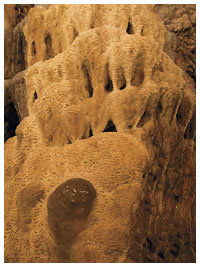

 The formations in the caverns are made of calcium carbonate and have taken thousands of years to develop. In order for the calcium to get into the caves and create formations, it must first go through both the carbonation process and, then, the decarbonation process. First, the carbonation process occurs as rainwater picks up trace amounts of carbon dioxide from the air. The water continues to pick up even more carbon dioxide as it passes through decaying and/or dead plant matter on its way through the ground. Once the water picks up the carbon dioxide, it becomes carbonic acid. This acid is very mild and can also be found in cola or other carbonated beverages. This carbonic acid, or carbonated water, is the agent by which calcium carbonate can be dissolved. Once this calcium carbonate is dissolved and turns from a solid to a liquid, it then becomes calcium bicarbonate, which brings us to the end of the carbonation process. At this point, the decarbonation process must occur for the beautiful rock formations to take shape.
The formations in the caverns are made of calcium carbonate and have taken thousands of years to develop. In order for the calcium to get into the caves and create formations, it must first go through both the carbonation process and, then, the decarbonation process. First, the carbonation process occurs as rainwater picks up trace amounts of carbon dioxide from the air. The water continues to pick up even more carbon dioxide as it passes through decaying and/or dead plant matter on its way through the ground. Once the water picks up the carbon dioxide, it becomes carbonic acid. This acid is very mild and can also be found in cola or other carbonated beverages. This carbonic acid, or carbonated water, is the agent by which calcium carbonate can be dissolved. Once this calcium carbonate is dissolved and turns from a solid to a liquid, it then becomes calcium bicarbonate, which brings us to the end of the carbonation process. At this point, the decarbonation process must occur for the beautiful rock formations to take shape.
The decarbonation process takes place when a drop of water with calcium bicarbonate enters the free air chamber of the caves. As soon as the drop enters a chamber, the carbon dioxide molecules leave the drop of water for two reasons. First, carbon dioxide molecules are heavier than air. And, second, the  atmosphere around the drop has less carbon dioxide molecules so the carbon dioxide molecules want to go into the air to equalize the pressure. As the equalization process occurs, the drop of water is left flat just as a carbonated beverage would if it were left out for a period of time. At this point, the agent that kept the calcium carbonate in the water has left -- and must leave the solution and crystallize. The crystals formed by calcium carbonate are six-sided and are referred to as calcite crystals. At the rate of one cubic inch every 100 to 150 years, trillions of these calcite crystals add up to create a whole range of delicate formations referred to as speleothem. The formations found in Crystal Grottoes Caverns include: stalactites, stalagmites, columns, bacon, ribbons, blanket or drapery types, soda straws, rim stone pools, saw tooth or serrated edges, along with the popcorn, grape, and cauliflower types of helectites.
atmosphere around the drop has less carbon dioxide molecules so the carbon dioxide molecules want to go into the air to equalize the pressure. As the equalization process occurs, the drop of water is left flat just as a carbonated beverage would if it were left out for a period of time. At this point, the agent that kept the calcium carbonate in the water has left -- and must leave the solution and crystallize. The crystals formed by calcium carbonate are six-sided and are referred to as calcite crystals. At the rate of one cubic inch every 100 to 150 years, trillions of these calcite crystals add up to create a whole range of delicate formations referred to as speleothem. The formations found in Crystal Grottoes Caverns include: stalactites, stalagmites, columns, bacon, ribbons, blanket or drapery types, soda straws, rim stone pools, saw tooth or serrated edges, along with the popcorn, grape, and cauliflower types of helectites.
The Crystal Grottoes Caverns were formed in a syncline, or a downward sloping fold in the earth. This downward sloping fold is created when several rock layers are compressed and pushed together much like you would see with folds in a carpet that gets pushed together. In this case, the syncline, which is shaped like a dish with rock on either side, is made up of solid limestone running down 1200 to 1500 feet. As the rock layers were compressed to form the syncline, the limestone fractured creating faults or cracks. During periods of frequent rain the faults fill up with ground water that has picked up carbon dioxide molecules both from the air and decaying plant matter. This process of dissolving out the cave through a solution is very different from the process where some caves form by moving water washing away the rock.
Instead of the rock washing away from moving water, the Crystal Grottoes Caverns were formed by groundwater that dissolved through the limestone at a rate of 10 feet per year. Also known as solution caves because of this formation process, the Crystal Grottoes Caverns are the only commercialized caverns on the east coast to have formed in a syncline through this process. One can only imagine that the workers that discovered the caves in 1920 had no idea that they were discovering such a large and unique solution cave with hundreds of thousands of beautiful formations that took thousands of years to be created.